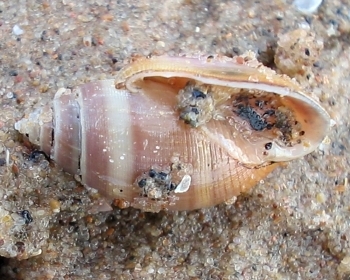
Acteon tornatilis
Linnaeus, 1758
Order: CEPHALASPIDEA
Superfamily: ACTEONOIDEA
Family: Acteonidae
DISTRIBUTION
North Atlantic coast of Europe from Iceland and Norway, British Isles, France, and the Mediterranean.
PHOTO
Aberavon Beach, Port Talbot, on sand, South Wales, UK, 26 August 2006, sandy beach. Length: 2 cm. Photographer: Judith Oakley
Primitive opisthobranch with a heavily calcified spiral shell. The shell is pinkish brown with two white bands on the body whorl. The white animal can fully retract into the shell. There is a thin horny operculum.
The extended animal reaches about 3 cm in length and is found burrowing in sandy sediments from the low intertidal to over 200 meters. It is reported to feed on polychaete worms such as Owenia fusiformis and Lanice conchilega.
- Hurst, A. (1965) Studies on the structure and function of the feeding apparatus of Philine aperta with a comparative consideration of some other opisthobranchs. Malacologia, 2(3): 281-347.
- Thompson, T. E. (1976) Biology of opisthobranch molluscs. Vol 1. London, Ray Society no. 151. 1-207.
- Thompson, T. E. (1988) Molluscs: Benthic Opisthobranchs (Mollusca: Gastropoda). Leiden, The Linnean Society of London. 1-356.
- Yonow, N. (1989) Feeding observations on Acteon tornatilis (Linnaeus) (Opisthobranchia: Acteonidae). Journal of Molluscan Studies 55: 97-102.
Rudman, W.B., 2006 (October 27) Acteon tornatilis Linnaeus, 1758. [In] Sea Slug Forum. Australian Museum, Sydney. Available from http://www.seaslugforum.net/find/actetorn
Related messages
Acteon tornatilis trails, South Wales, UK
August 12, 2008
From: Judith Oakley
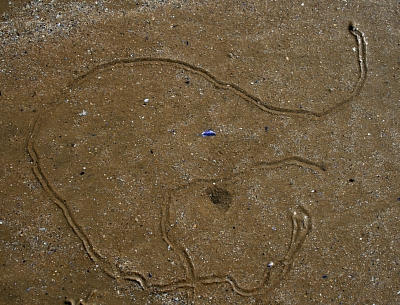
Hi Bill,
I thought the Forum might be interested in seeing some of the amazing trails that Acteon tornatilis makes on sandy shores here in South Wales, United Kingdom. I have also attached a close up of the shelled sea slug. The images are from Aberavon Beach, Port Talbot and Oxwich Beach, Gower.
Regards
Judith Oakley
jomoakley@binternet.com
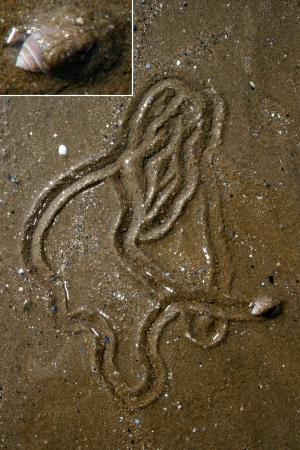

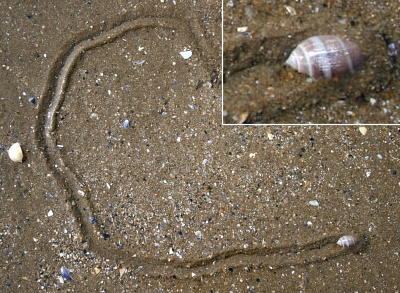
Dear Judith,
It's great to see photos of Acteon tornatilis. In the early 1970s I studied species of the related genus Pupa in New Zealand, so when I first went to the UK I was very keen to see the 'classic' Acteon tornatilis in action. Tom Thompson assured me that he could always find it, but despite trips to Plymouth and the Gower Peninsula with Tom I never did see it alive. I am afraid I have never found opisthobranchs to be the most reliable animals to study, even the most common having the ability to disappear overnight if they get the slightest inkling that a researcher is looking for them. I must say Acteon tornatilis reminds me of the totally unrelated olives in the way they are adapted for 'ploughing' through the sand.
I have changed your spelling Actaeon to the correct Acteon. Many older works incoreectly use the ae spelling.
Best wishes,
Bill Rudman
Acteon tornatilis from Malta
November 3, 2006
From: Constantine Mifsud
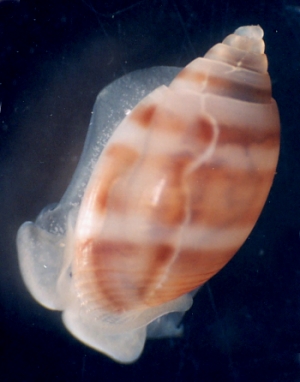
Concerning message #17726:
Bill,
Here is an image of Acteon tornatilis.
Locality: Off Gnejna Bay,, 40-50 metres, Malta, Mediterranean Sea, August 1997, muddy sand substrate. Length: 7 mm. Photographer: Constantine Mifsud.
Mediterranean specimens seem to be much smaller than those from the North Atlantic.
Constantine Mifsud
kejdon@orbit.net.mt
Mifsud, C., 2006 (Nov 3) Acteon tornatilis from Malta. [Message in] Sea Slug Forum. Australian Museum, Sydney. Available from http://www.seaslugforum.net/find/18174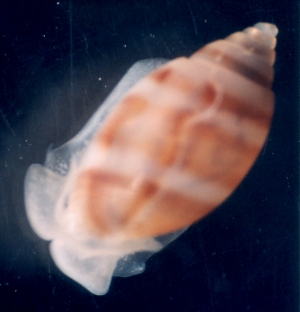
Dear Con,
Thanks for the photos. I have only seen this species alive once, and that was of specimens from southern England. From what I have read, Mediterranean specimens do seem to be much smaller and apparently lack the spiral and axial grooving on the shell.
Best wishes,
Bill Rudman
Acteon tornatilis from South Wales, UK
October 27, 2006
From: Judith Oakley
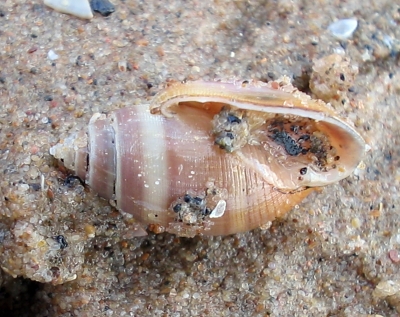
Hi Bill,
A new species for me - Acteon tornatilis - found on a sandy beach near my home town in South Wales. Not a marina survey this time! An interesting species as it is a shelled seaslug, feeding on the polychaete worm Lanice conchilega.
Locality: Aberavon Beach, Port Talbot, on sand, South Wales, UK, 26 August 2006, sandy beach. Length: 2 cm. Photographer: Judith Oakley.
Best wishes
Judith
jomoakley@btinternet.com
Oakley, J.A., 2006 (Oct 27) Acteon tornatilis from South Wales, UK. [Message in] Sea Slug Forum. Australian Museum, Sydney. Available from http://www.seaslugforum.net/find/17726Dear Judith,
It's nice to get a mention of this interesting 'primitive' opisthobranch. It was long considered a detritus feeder, I suspect because that best fitted the scenario that as a primitive opisthobranch it should have a primitive unspecialised feeding behaviour. However Anne Hurst (1965) reported that it was a specialised vermivore, and this behaviour was studied in some detail by Nathalie Yonow (1989).
If anyone has a photo of the living animal, I would love to include it on the Forum.
- Hurst, A. (1965) Studies on the structure and function of the feeding apparatus of Philine aperta with a comparative consideration of some other opisthobranchs. Malacologia, 2(3): 281-347.
- Yonow, N. (1989) Feeding observations on Acteon tornatilis (Linnaeus) (Opisthobranchia: Acteonidae). Journal of Molluscan Studies 55: 97-102.
Best wishes,
Bill Rudman
